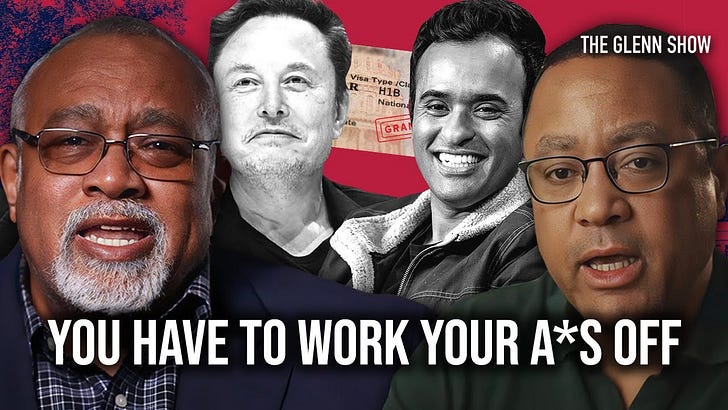The debate over H-1B visas is the first major public dispute of Trump’s second term, and that term hasn’t even started yet. The visa program is generally popular with businesses that want to bring in technical talent from overseas, but it’s run afoul of the “America First” faction in Trump’s coalition. Why not train and hire American workers instead? As John and I discuss in this clip, it may not be that easy.
This is a clip from the episode that went out to subscribers on Monday. To get access to the full episode, as well as an ad-free podcast feed, Q&As, and other exclusive content and benefits, click below.





I haven't read this yet but.... when you have a dismal school system that focuses on dei as opposed to quality education,. this is what you get
Concerns about the use of H-1B visas are a subplot in a much larger debate about the falling share of Americans achieving the American Dream, defined as doing at least as well, financially, as their parents.
Raj Chetty and other researchers established a while ago that the odds of earning more at age 30 than one's parents did at the same age, adjusted for inflation, fell from 90% for those born in 1940 to 50% for those born in 1980:
https://www.science.org/doi/10.1126/science.aal4617
What was an almost sure thing became a coin flip in 40 years. What Chetty and his collaborators referred to as "The Fading American Dream" has led to widespread economic anxiety and the rise of populism.
The key drivers of the fading American Dream are globalization, automation, and immigration.
Immigration is front and center today because immigrants account for 18-19% of America's labor force and over 14% of the population, the highest level since the late 1800's:
https://www.bls.gov/news.release/pdf/forbrn.pdf
https://www.pewresearch.org/short-reads/2024/09/27/u-s-immigrant-population-in-2023-saw-largest-increase-in-more-than-20-years/
The immigrant share of the labor force has been growing while the share of native-born Americans, especially men, has been falling. Here's an excerpt from a NY Post article that illustrates the point:
https://nypost.com/2024/12/21/us-news/native-born-us-workforce-totals-dipped-as-immigrant-labor-figures-rose-report/
The American labor force is becoming less American.
Newly-released data from the Center for Immigration Studies is sounding the alarm on the declining US labor force, by showing fewer native-born Americans are joining the workforce — with men representing the largest decline seen in decades.
“The share of working-age (16 to 64) U.S.-born men not in the labor force increased from 11 percent in April 1960 to 17 percent in April 2000, and to 22 percent in April 2024,” the analysis found.
“Among ‘prime-age’ U.S.-born men (25 to 54), the group most likely to work, the share not in the labor force was 4 percent in April 1960, 9 percent in 2000 and 12 percent in 2024.”
The study concluded 43 million men and women — born in the US and aged 16 to 64 — were not working as of last April, which is 8.5 million more than in 2000.
These trends fuel economic anxiety and feed the populism that comes with it. So does automation. Concerns about the use of labor-saving forms of automation were a major sticking point in the just resolved negotiations between the International Longshoreman's Association (ILA) and the United States Maritime Alliance (USMX):
https://edition.cnn.com/2025/01/08/business/us-dockworkers-port-employers-agreement/index.html
Indicative of how big a force populism has become, both Biden and Trump sided with the ILA on the automation issue.
Last, but not least, there's evidence that shows American adults are less literate and numerate than they were in 2012. The just released Program for International Assessment of Adult Competencies (PIAAC) results illustrate the point:
https://nces.ed.gov/surveys/piaac/2023/national_results.asp
These worrisome trends are taking place despite massive growth in K-12 spending. Per pupil spending, adjusted for inflation (constant 2022-23 dollars), was $6,474 in 1969-70 vs. $17,495 in 2020-21:
https://nces.ed.gov/programs/digest/d23/tables/dt23_236.70.asp
Total K-12 expenditures were $927 billion in 2020-21:
https://nces.ed.gov/programs/coe/indicator/cmb
To make a long story short, the debate about H-1B visas is a symptom of justifiable economic anxiety. The key questions are why are Americans falling behind and what can we do about it? Two primary narratives have emerged:
1. The system is rigged against average Americans in ways that favor elites
2. American culture needs to change in ways that embrace education and emphasize the importance of hard work
There are elements of truth in both narratives, so a nuanced approach is needed. American politics are so polarized and dysfunctional, however, that this is unlikely. Politicians will embrace the rigged system narrative even though it's obvious that many Americans aren't competitive with their global peers despite massive increases in K-12 spending.